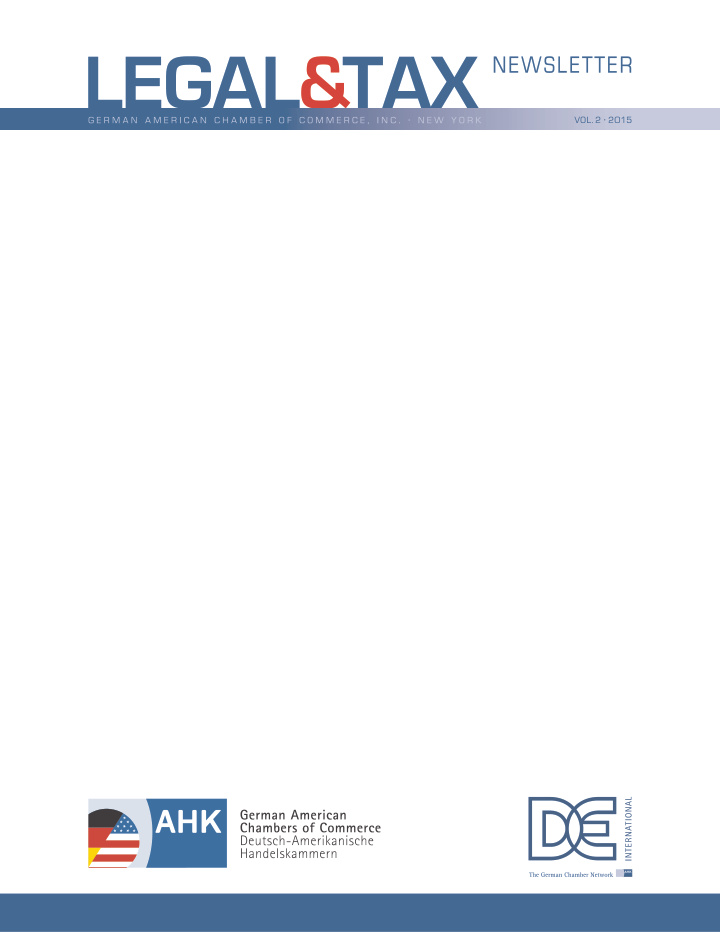



VOL. 2 • 2015
VOL. 2 • 2015 Protecting Art Experts from Frivolous Suits Recent art forgery scandals in Germany (Beltracchi) and New York (Knoedler Gallery) have shaken up the international art world. Auction houses, galleries, and art experts are increasingly sued for selling or authenticating forged art. At the same time, there are more and more lawsuits against art experts over their refusal to authenticate certain artworks. Artist foundations and independent art experts in Germany and the U.S. used to routinely authenticate art works, but they now find themselves between a rock and a hard place: they may be sued if they authenticate a work, and they may be sued if they don’t! Birgit Kurtz Director, Business & Commercial The Warhol Case Litigation Department The recent Warhol case illustrates the problem. In 1989, Joe Simon-Whelan purchased a D +1 (212) 613 2009 F +1 (212) 554 9618 painting ostensibly created by Andy Warhol. Over the years, the painting was authenticated bkurtz@gibbonslaw.com by different Warhol experts. In 2001, Mr. Simon-Whelan asked the Andy Warhol Gibbons P.C. Foundation to authenticate the painting, but the Foundation denied his request. This One Pennsylvania Plaza, denial, of course, had a substantial effect on the fair market value of the painting. 37th Floor New York, NY 10119 Mr. Simon-Whelan sued the Foundation, arguing, among other things, that the www.gibbonslaw.com Foundation abused its monopoly position regarding the authentication of Warhol works. The case ended after more than three years, when Mr. Simon-Whelan withdrew his complaint due to waning financial resources. By that time, the Andy Warhol Foundation had spent $6.6 million on its defense in that case alone. Because of this expense (and defending against about ten other lawsuits), the Andy Warhol Foundation recently ceased its authentication activity. Similar lawsuits have involved works (supposedly) by Jackson Pollock, Alexander Calder, Jean-Michel Basquiat, and Robert Motherwell. Art Market Impact None of the lawsuits has resulted in a verdict against the art experts or authentication boards, but the litigation costs have reached millions of dollars. Contrary to the “loser pays” rule in Germany, in the U.S., each party bears its own costs and fees. Thus, even when they won the cases, the experts lost substantial amounts of money in the course of defending themselves. As a consequence, several artist foundations and estates have ceased their authentication activities ( e.g., the Pollock-Krasner Foundation, the Estate of Jean-Michel Basquiat, and the Roy Lichtenstein Foundation), and independent art experts have sharply curtailed their authentication activities for fear of having to spend large sums of money to defend against what they deem frivolous claims. Many of them have raised their insurance coverage, making authentication more expensive. It has therefore become difficult to have certain art works authenticated. A “covenant not to sue” or an “obligation 11
VOL. 2 • 2015 Birgit Kurtz Protecting Art Experts from Frivolous Suits Director, Business & Commercial Litigation Department D +1 (212) 613 2009 to hold harmless” can be added to a contract between an authenticator and the owner of F +1 (212) 554 9618 a work of art, but those types of clauses have also been attacked in court. bkurtz@gibbonslaw.com Also, when previously unknown (and thus suspect) art works enter the market, art Gibbons P.C. experts are now much more hesitant to publicly raise doubts – out of fear that they will One Pennsylvania Plaza, be sued. Hence, art market insiders are predicting that forgeries will flood the market. 37th Floor New York, NY 10119 www.gibbonslaw.com New York State Legislation Because New York is considered one of the world’s major art markets, the New York State Legislature is contemplating a bill designed to protect art experts from frivolous lawsuits. The Bill (A.9016/S.6794) would amend the “New York Arts and Cultural Affairs Law” by providing certain procedural protections to authenticators (as defined in the Bill). Proposed Definition An authenticator under the bill is defined as someone who: (a) is recognized in the visual arts community as having expertise regarding the artist or work of fine art at issue; (b) has no financial interest in the work of art at issue or in any transaction concerning that work of art; and (c) acts in good faith. Proposed Procedural Changes The Bill proposes that: 1. the factual allegations against the authenticator must be specified with particularity (rather than by “short and plain statement”); 2. each element of the claim must be proven “by clear and convincing evidence” (rather than “by a preponderance of the evidence”); and 3. a losing plaintiff bears the authenticator’s reasonable attorneys’ fees, costs, and expenses (rather then each party bearing their own fees, etc.). These procedural changes (similar to existing German rules) are designed to discourage frivolous lawsuits against art authenticators and to protect them financially when they must defend themselves against frivolous lawsuits. If these changes help to curb the influx of forgeries into the international art market, they are certainly welcome! UPDATE: On June 15, 2015, the New York State Senate approved a similar bill. 12
Recommend
More recommend